Are there early signs that things are changing under the new bosses? There is no greater fool’s game than trying to predict the fortunes of a football club based on one league fixture, and this applies doubly for teams with new managers. When clubs make managerial changes during the season, there is often an emphasis on getting instant results, but for coaches employed over the summer, the feeling tends towards letting them build something more concrete. As such, Frank Lampard, Graham Potter and Steve Bruce will have to wait a little while before I or anyone else could credibly claim they’re doing a good or bad job. Nonetheless, one match does offer clues as to how they will approach things going forward, what ideas from previous jobs they will take with them to their new clubs. As such, let’s take a look at what little we’ve already learned about the new men in charge at these three Premier League sides.
Chelsea
Anyone who watched Chelsea last season could see, both in a positive and negative sense, Maurizio Sarri trying to implement his very strict ideas of possession football to players who had mostly worked in completely different styles. Jorginho came in as the key signing at the base of the midfield to dictate this short passing style. The aim was to produce some really intricate football that at times saw rapid movements towards the goal, but this was only partially successful. At their worst, Sarri’s Chelsea were a passive tiki taka side that moved the ball sideways a lot and struggled to offer much incision, even if things were often better than that caricature paints them. For Lampard, the job is less about building a strong footballing philosophy between the lines than moving away from such a rigid one. The real identity he wants to promote is off the pitch, a culture at the club where young players are given first team opportunities and everyone is pulling in the same direction. This would differentiate himself from his predecessors after Sarri and Antonio Conte’s first team set ups seemed completely cut off from everything else happening at Chelsea. The Englishman has a squad made up of a mishmash of players who suited Sarri’s style, players who performed better under Conte’s deep defending, and players who were out on loan doing something completely different. And so, if he’s going to put the players before the philosophy as he seems to intend to do, the style is going to be a bit less distinct. “Chaotic” was probably the word best used to describe Chelsea’s 4-0 defeat to Manchester United. Lampard’s side played a straightforward 4-2-3-1 shape and looked like the plan was to press aggressively against United, but they had no clear structure in terms of how to do it. Pressing systems aren’t exactly the easiest thing to coach. It took Jurgen Klopp’s Liverpool a full two years and numerous personnel upgrades before they stopped conceding too many goals to basic errors, owing in part to the individuals but also a system that often left them exposed. It felt like some of this was at play with Chelsea today. As seen in the pressure frequency heatmap below, they pressed a lot but not with any kind of obvious pattern or plan. 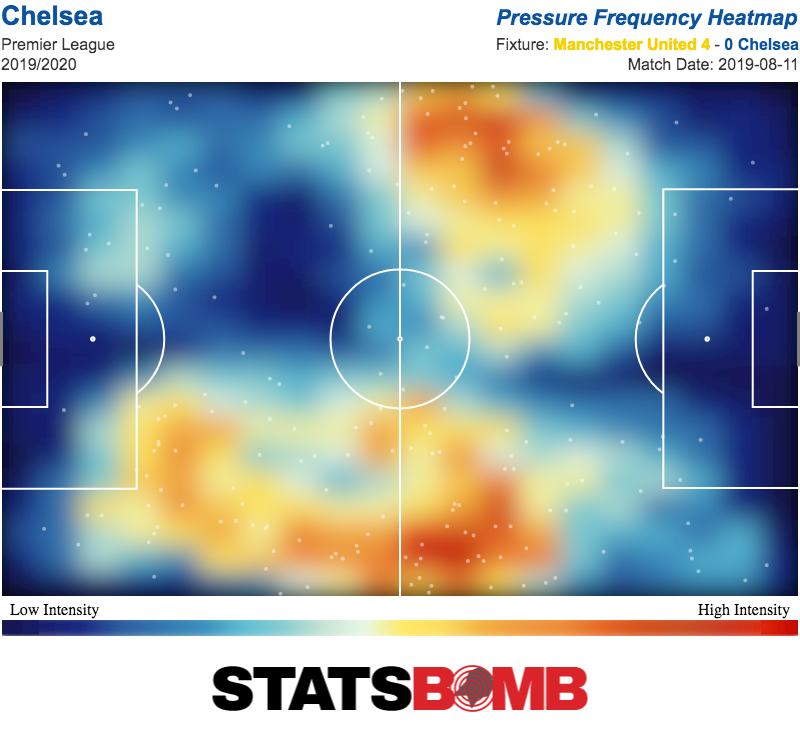 Zouma in particular was horribly exposed by this, and no one could really claim that the centre back had anything other than a bad game. But he certainly wasn’t helped by what was happening in front of him, with Chelsea throwing players forward without much in the way of structure. The good news is that N’Golo Kante is to return, and he is surely the best player in the world at being a one man fix for a side’s poor defensive structure. This should ideally tide Chelsea over until everyone can get to grips with how to press in a cohesive manner. In terms of the midfielders who did start, Jorginho and Mateo Kovacic feel like a less than ideal partnership. Jorginho himself was seen as the avatar of Sarriball, and questions have been raised over whether he can even play in a double pivot embracing a faster style of football. Looking at his passes during the game, it doesn’t look like anything has changed for him, with a high volume of the kind of stuff that frustrated Chelsea fans last year, the sideways balls around the halfway line, still making up most of his work.
Zouma in particular was horribly exposed by this, and no one could really claim that the centre back had anything other than a bad game. But he certainly wasn’t helped by what was happening in front of him, with Chelsea throwing players forward without much in the way of structure. The good news is that N’Golo Kante is to return, and he is surely the best player in the world at being a one man fix for a side’s poor defensive structure. This should ideally tide Chelsea over until everyone can get to grips with how to press in a cohesive manner. In terms of the midfielders who did start, Jorginho and Mateo Kovacic feel like a less than ideal partnership. Jorginho himself was seen as the avatar of Sarriball, and questions have been raised over whether he can even play in a double pivot embracing a faster style of football. Looking at his passes during the game, it doesn’t look like anything has changed for him, with a high volume of the kind of stuff that frustrated Chelsea fans last year, the sideways balls around the halfway line, still making up most of his work. 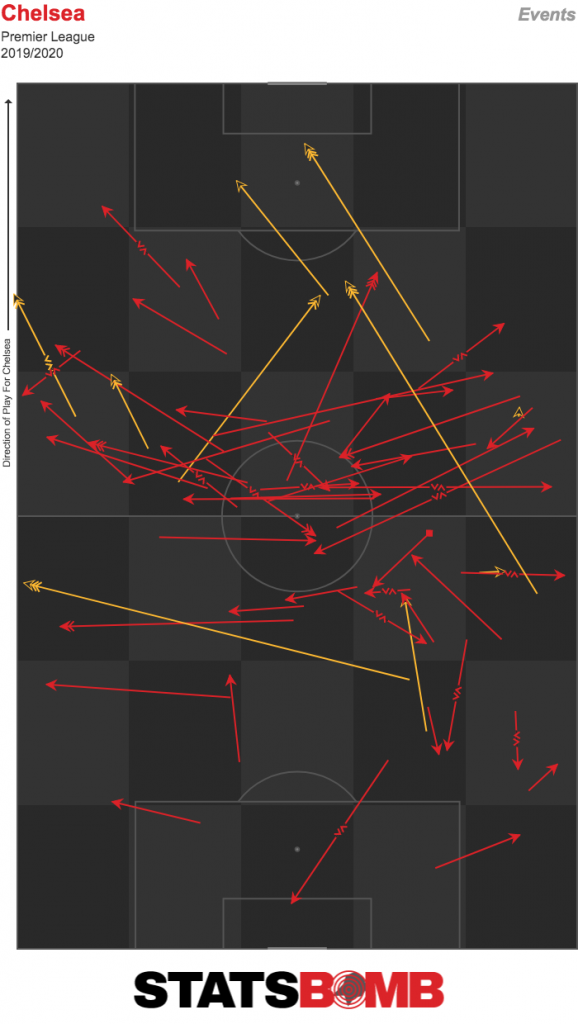 This actually looks more prominent than in his performance at Old Trafford last April, where we saw him completing passes in more varied areas.
This actually looks more prominent than in his performance at Old Trafford last April, where we saw him completing passes in more varied areas. 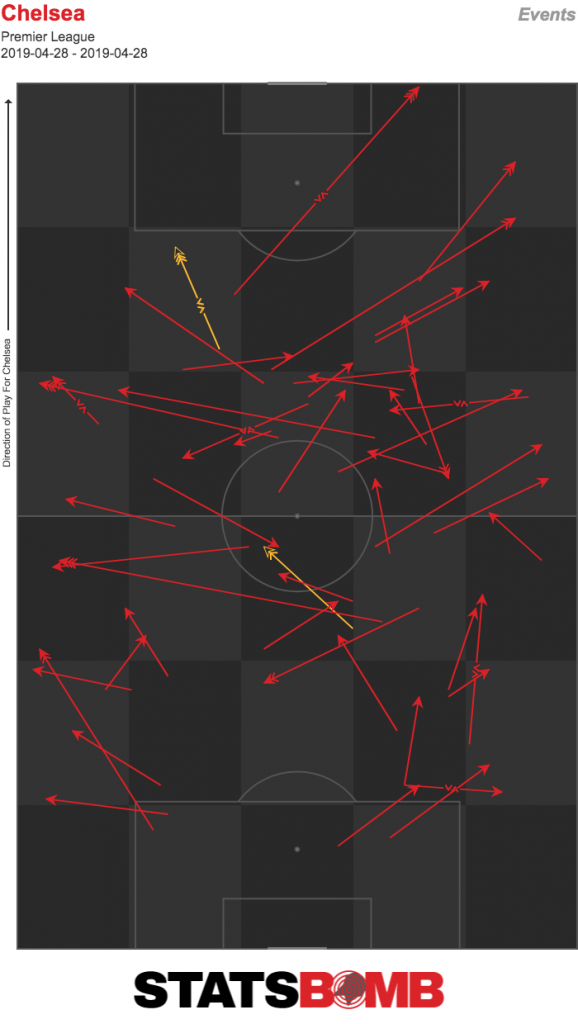 The plan for Lampard seems to be to have Mason Mount leading the press as a number ten (which he did to reasonable effect, putting up the most pressures of any Chelsea player) behind Kante as the destroyer and either Jorginho or Kovacic as the more creative midfielder. Neither could really say they won the audition here. The main issue presented in this game was a lack of compactness and Lampard will have to do plenty of work on the training field to get to what he wants. But there’s no reason to panic, and the idea of this Chelsea team is still solid. We’ll have to check in later in the season to see if he’s capable of coaching this side.
The plan for Lampard seems to be to have Mason Mount leading the press as a number ten (which he did to reasonable effect, putting up the most pressures of any Chelsea player) behind Kante as the destroyer and either Jorginho or Kovacic as the more creative midfielder. Neither could really say they won the audition here. The main issue presented in this game was a lack of compactness and Lampard will have to do plenty of work on the training field to get to what he wants. But there’s no reason to panic, and the idea of this Chelsea team is still solid. We’ll have to check in later in the season to see if he’s capable of coaching this side.
Brighton
Unlike Lampard’s Chelsea, we have a much clearer idea of how Graham Potter would like Brighton to play football. The 3-0 scoreline certainly flattered the Seagulls at Watford, with expected goals putting it as a fairly close encounter that Watford shaded (though it should be noted that that doesn’t account for the own goal, and Brighton would have likely had a very high xG chance had Doucoure not put the ball in his own net). 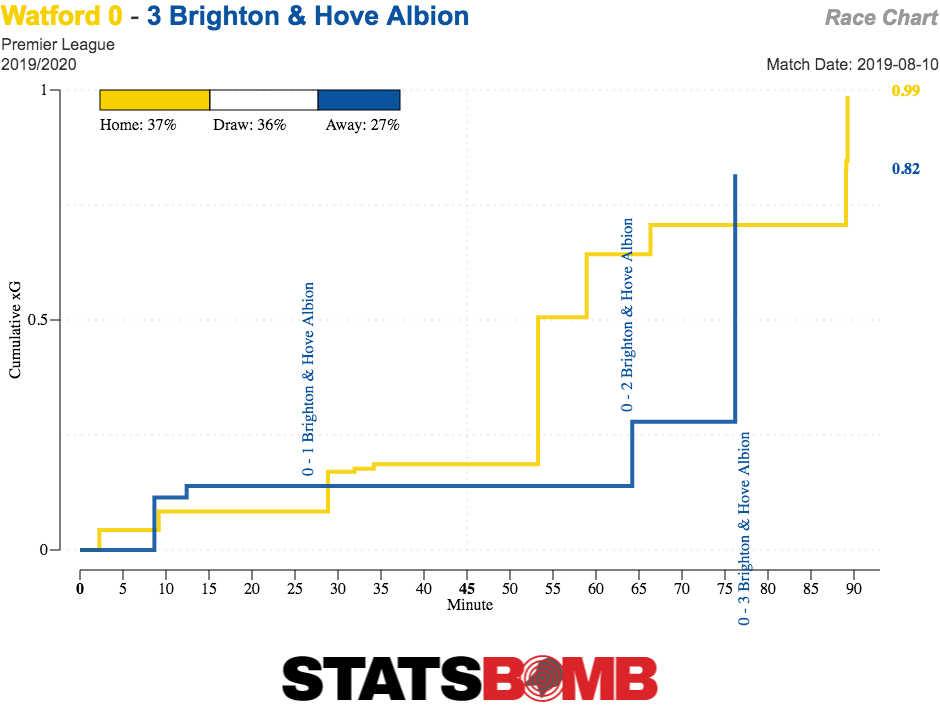 There were plenty of reasons beyond the scoreline for Brighton to be positive, though. They were tactically the better side, creating chances from a clear structure of how they wanted to play while Watford focused more on individual quality. The passmap tells much of the story of Brighton’s game: retain possession in deep areas with lots of short passing, then wait for space in the opposition half and launch a fast counter.
There were plenty of reasons beyond the scoreline for Brighton to be positive, though. They were tactically the better side, creating chances from a clear structure of how they wanted to play while Watford focused more on individual quality. The passmap tells much of the story of Brighton’s game: retain possession in deep areas with lots of short passing, then wait for space in the opposition half and launch a fast counter. 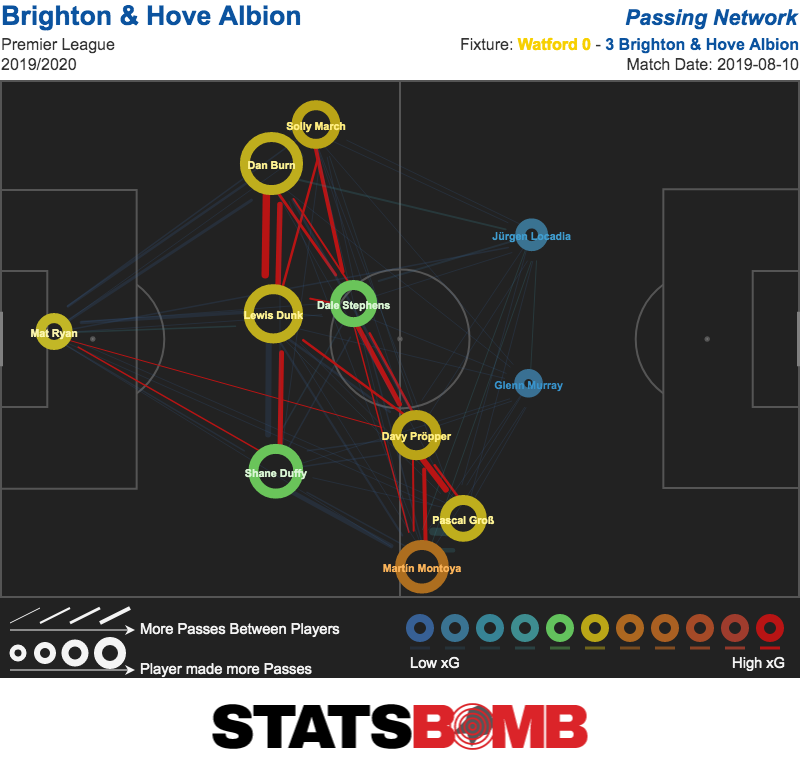 They didn’t worry too much about forcing the issue, either, with the pressure map showing that the defensive work was mostly done in their own half.
They didn’t worry too much about forcing the issue, either, with the pressure map showing that the defensive work was mostly done in their own half. 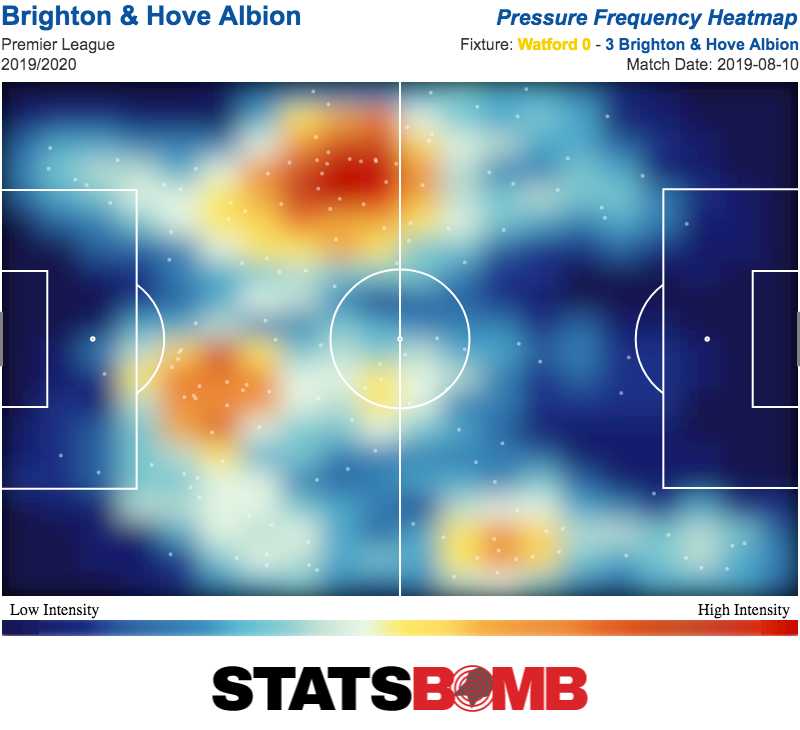 Potter has a fairly specific style, so it’s a good sign that we’re already seeing the core principles at play in game one. Better news still is that none of the new signings started, so there is ideally still value to be added. It seems like 3-4-3 is the preferred system for now, and while the attacking band still hasn’t settled, what seems probable is a first choice combination of Pascal Gross just behind new signings Leandro Trossard and Neal Maupay. We still don’t know if Maupay and particularly Trossard are good enough for the Premier League, but it’s a front three that would provide a good range of qualities, with Gross’ creative passing threat meeting Trossard’s dribbling and Maupay’s mobile forward play. The very, very early signs are positive for Potter’s Brighton.
Potter has a fairly specific style, so it’s a good sign that we’re already seeing the core principles at play in game one. Better news still is that none of the new signings started, so there is ideally still value to be added. It seems like 3-4-3 is the preferred system for now, and while the attacking band still hasn’t settled, what seems probable is a first choice combination of Pascal Gross just behind new signings Leandro Trossard and Neal Maupay. We still don’t know if Maupay and particularly Trossard are good enough for the Premier League, but it’s a front three that would provide a good range of qualities, with Gross’ creative passing threat meeting Trossard’s dribbling and Maupay’s mobile forward play. The very, very early signs are positive for Potter’s Brighton.
Newcastle
From a manager who has a very particular style to, well, Steve Bruce. If Bruce succeeds at St. James’ Park, it won’t be because he’s imparted his clear footballing philosophy onto the players. He doesn’t have one. It’ll be because he gets the most out of the players at the club with a fairly straightforward approach. He’s inherited strong defensive foundations from his predecessor Rafa Benitez and would be best advised not to mess with that side of things too much. Thus most of the changes might come from the new attacking signings offering some different qualities. Joelinton was the one new arrival to start against Arsenal and he made a positive impact. In last season’s home fixtures against top six sides, Newcastle started both Salomon Rondon and Joselu at different times. Benitez always liked his strikers to contribute without the ball, but Joelinton may have the pair beat on this front. The Brazilian made 41 pressures against Arsenal, more than either Joselu or Rondon managed in any home game against top six clubs last year. He also managed 131 touches, the most of any Newcastle player this weekend. When you’re playing against a clearly superior opponent and register just 39% possession, you do not typically expect your striker to have the most touches of the ball. Add in that his 8 aerial wins were the most of any Newcastle player and you have a genuine all round performance. There are still questions over whether Joelinton can consistently generate enough good shots to be value for money at £40m, but Newcastle have a number nine who offers a lot outside of scoring goals. The other big new attacking signing, Allan Saint-Maximin, only got a brief substitute appearance so we can’t conclude much there. In the past, Saint-Maximin has been an extremely high volume dribbler (4.88 per 90 last season) who struggles to turn this into shots or chance creation. While the hope is obviously that he develops his game beyond this, he can still be of some use as the limited player he is right now. Newcastle were often very, very deep last season under Benitez, and being able to get up the pitch more easily could actually help defensively. Kenedy (now back at Chelsea) offered this kind of dribbling quality to get Newcastle forward at times, but Saint-Maximin is arguably an even better option for this. The Frenchman will almost certainly frustrate at times with his quality once he gets to the byline, but just having someone who can dribble the ball up there will be of use in Tyneside. Header image courtesy of the Press Association